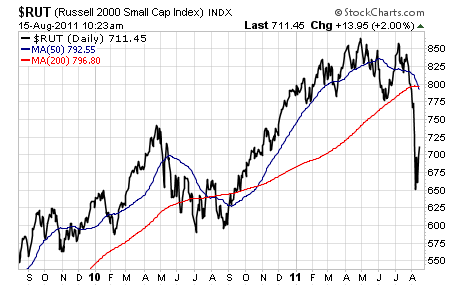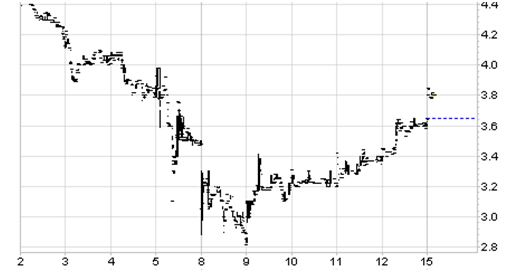It's been a wild ride lately. I think this two year chart of the Russell 2000 Small Cap Index pretty much sums it up.

There are a lot of opinions being offered regarding the current state of the U.S., European and global economy. I'm sure you've heard many of them so I won't go into great detail here today.
The bottom line is that evidence suggests GDP growth is slowing, despite government stimulus. And many governments, ours included, are running out of options given their relatively high debt to GDP levels and already low interest rate policies.
Yet corporate profits and liquidity remain very high, and in fact many companies continue to beat analyst expectations. So while governments may be struggling, many companies are doing quite well – including the vast majority of our holdings in the Small Cap Investor PRO portfolio.
Until very recently things were ticking along quite steadily for the stock market. Capital has a way of seeking out growth and with low interest rates, stocks are extremely attractive. It doesn't take a 'saver' long to realize that a ten year Treasury yielding roughly the same as the S&P 500 – around 2.2 percent – is a raw deal. That is of course, until stocks begin to tank…
So the markets, which represent the collective views of investors, are trying to figure out where the world's economies will go from here and how they'll deal with the reality that policy makers are running out of ammunition. Capital also has to go somewhere, and despite volatility, stocks are the most compelling option.
Personally, I'm a bit relieved to see that policy makers are running out of options. Maybe we'll eventually get to a place where markets actually decide how to allocate capital instead of Washington DC. Wouldn't that be a welcome relief!
Dealing with Short-Term Market Volatility
I am a firm believer that the ever increasing complexity of everything from policy and currency wars, to ETFs and high frequency trading makes it exceedingly difficult for retail (and for that matter most professional) investors to accurately predict the short-term movements of the market.
This difficulty is especially true for small cap investors and is best discussed with a specific example.
Below is a 10-day chart of a stock that I have been monitoring for possible inclusion in our premium portfolio (note that I removed the name). Over the last ten days this stock fell by as much as 36 percent and is now off around 13 percent – but what's more amazing are the extreme swings in the stock's price intraday. Notice the outlying orders that were completed between August 5 and August 10.
On August 5th, this stock jumped at the open, fell 10 percent, bounced back to around $3.90 then consecutive jumps down culminated in a single order around $3.10, or roughly 20 percent below the day's high. The next day, August 9th, this stock appears to have bottomed around $2.80 – that's 20 percent below the August 5 close – in yet another volatile session.
For an investor that owns this stock, or was considering adding shares to his portfolio, this type of price action is likely to result in a groan or two – from feelings of either pain or missed opportunity.

As I watch these types of price movements it's clear that an unwary investor trying to tame this beast can get sucked in, ground up, and spit out the other side both poorer and more confused than ever.
So for most investors it's best not to get too caught up in the market's daily fluctuations since – given the lack of news specific to this security – fundamentals are clearly not driving price action. Naturally, this is easier said than done and I'll admit to more than a few hours over the past couple of weeks spent pulling my hair and staring at my trading screen. After all, I'm only human.
But stock corrections are a process, not a single point in time, and trying to be a hero at these times is usually fatal. Violent corrections, like the one we have been experiencing, happen too quickly for most investors to capture quick gains. Efforts to time the yo-yo action of the correction leads to too much buying of companies that will still go down, and too much selling of positions that are likely to go up.
So it is all the more important that investors stick to a clear and simple strategy during violent stock market gyrations and don't try to get 'too cute'.
You may have your own strategy. Mine is to buy attractive growth companies, at reasonable valuations, with significant exposure to global growth trends. I'll take gains on some winners along the way, cut some losers, and attempt to significantly outperform the overall market.
With this strategy guiding my decisions, the recent market action is a time to average into more shares of my conviction positions using limit orders. I can stick to this strategy because I'm not investing money that I need to pay next month's mortgage, or to by wood for the stove this winter. I'm an investor, not a trader.
If I need, or want, more capital, I'll sell those positions that I have less conviction in – even if that requires taking a modest loss – since I'd rather use the capital to buy a 'great deal'.
An Opportunistic Strategy for Periods of Volatility
My strategy doesn't mean I can't be opportunistic in a volatile market – quite the opposite in fact. In the past I've advocated using limit orders (as opposed to market orders) during periods of extreme market volatility to try and average into your conviction 'buy and hold' positions.
Let's use the stock above as an example, and let's assume this is a position you are confident in and want to buy more of – even if you believe the stock market could sell off further.
Go ahead and enter a limit order, to expire that day, to purchase shares at 20 percent below (you'll have to determine your own price that seems 'too good to be true') the current market price. Then walk away from the computer. Your order just might go through, and if it does you'll have added to your conviction buy and hold position at a heck of a discount.
I'll add that last week I did just this, increasing my holdings in one position by around 60 percent on a day the stock dropped by 18 percent. I'm not expecting this stock to post immediate gains, but over the next year or two I am confident this 'conviction buy' will pay off. Like I said earlier, this isn't my firewood money so time is on my side.
At other times certain stocks aren't moving too quickly to catch, and they are just too attractive to pass on.
This was the case Thursday when a prior portfolio holding traded at a depressed price for the third consecutive day. With the yield on this stock above 12 percent, it was time to pull the trigger and add it back to the portfolio.
What made this addition even better was that we had just sold it for a nice 16.2 percent gain a week earlier. The opportunity to buy it back for 20 percent less than our original cost basis was just too good to pass on and highlighted what I perceived to be a complete breakdown between share prices and fundamentals. I expect this position will also pay off over the next year.
So the bottom line is this – while the market might be intimidating when it's swinging all over the place, keep your cool. Don't try to be a hero.
But at the same time if you have a strategy – and you should – stick to it. Realize that these are the days you probably were dreaming about for months – when your watch list stocks are selling at 'too good to pass' prices.
Click here to read more articles from the Small Cap Investor Daily blog.
 Facebook
Facebook
 Twitter
Twitter